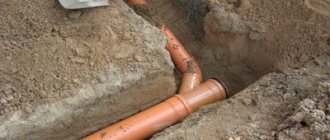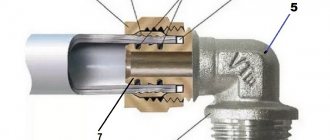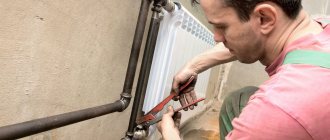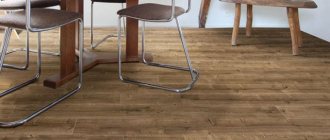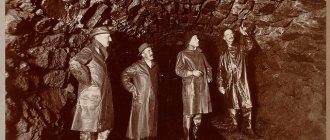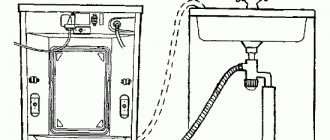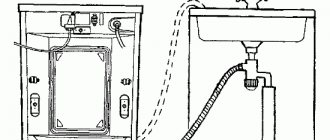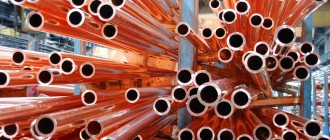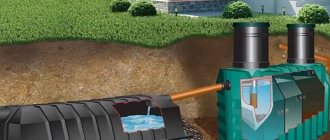To properly install a sewer system in a private house, they first dig a trench.
All standards - depth, wall reinforcement - must be met in accordance with regulatory documents.
If you organize the digging of a trench and its further arrangement incorrectly, there is a risk that an emergency situation will arise in the future.
To avoid consequences, they adhere to SNiP acts and also follow digging technology.
When is it used?
It is impossible to organize normal conditions for a comfortable life in a house without a sewer system. Passing through the internal pipeline, waste is transported to external mains, along which it reaches the septic tank.
If pipes are laid in trenches correctly, such a system can exist for several decades. To organize a sewer system, trenches are first dug.
There are several situations when rutting is necessary:
- pipes should not be located in a visible place on the site;
- the distance from the object to the septic tank is large and it will not be possible to lay a pipe on the surface;
- climatic conditions;
- compliance with regulatory requirements;
- protection from mechanical damage;
- saving land on the site.
There are situations when laying pipes in trenches is impractical. This is influenced by the harsh climatic conditions in which a tenth of the country lives.
For example, if the average annual temperature in a region is too low, then permanent frost is observed. Sewage pipes laid in the ground may freeze. Because of this, they are placed on the surface of the earth. The location on top of the ground is also convenient for repair work.
Also, laying a pipe underground does not make sense if the outer section is small. Then you can install sewer pipes on top of the ground, leading them to the septic tank.
We replaced the cesspool with a septic tank and have no regrets
My husband's parents live in their house in the village. In the fall of 2014, they installed a bioremediation station on the site. In fact, this is not a septic tank, but an individual autonomous sewage system for the house.
Before that, they had a small cesspool half a meter deep and a wooden house on top. She was not served at all. The pit served as an ordinary toilet - water did not flow there from baths and sinks, so a pumping machine was not ordered. In the spring it was flooded by groundwater, but not critically.
Such a pit was inconvenient for permanent residence in the house. My father-in-law didn’t want to lay a lot of pipes, worry about the smell and have to deal with pumping. That’s why he bought a station: it purifies wastewater by 97% and you can water your garden with this water.
The station cost about 80 thousand rubles plus 40 thousand for installation. She was buried in the ground to a depth of about three meters. The station processes 1 m3 of water per day and is designed to accommodate five people in a house, mainly in the summer.
Inside, it is divided into four compartments: one for purified water, two for dirty water and waste - this is where most of the bacteria live - and another compartment for sludge. Bacteria that live inside the station break down waste into water and sludge. The sludge needs to be pumped out once a quarter, for this there is a pump inside. It also serves for the daily operation of the station: it pumps water from one container to another and circulates air so that microbes live and work peacefully.
The compressor runs around the clock and consumes about 60 watts - about the same as a regular incandescent lamp. If the light is turned off for several hours, the bacteria may die without air - they will have to be repopulated inside the chamber. Once every few years, the station must be completely cleaned and all liquid pumped out from the inside. At the same time, it is advisable to change the membrane in the compressor so that it works better after cleaning.
We pump out the purified water using a pump. In winter once every two days, and in summer - constantly. It all depends on the number of people who live in the house.
The father-in-law is pleased with the work of the station. He believes that a station is definitely needed if the site has clay soils, high groundwater, or if many people constantly live in the house.
This is what the station looks like from the outside. If there is too much water in the receiving chamber, a warning light turns on
Parameters and requirements
When independently digging a trench and laying pipes in it, they are guided by the SNiP 2.04.03 collection from 1985. The regulatory document specifies clear standards for the depth, width and rules for strengthening the trench.
For a private house, the requirements will be as follows:
- pipes are laid at a depth of 0.8 to 1.4 meters in a trench;
- the freezing depth in central Russia is 300 mm, so the pipe should lie 30-50 cm below the freezing level;
- from the surface of the soil to the pipe itself should be at least 70 cm.
When organizing the system under a concrete platform, as well as in places where road transport constantly passes, the minimum values of the system level are increased by 1 meter. This is necessary to reduce the risk of soil subsidence due to intense loads on it.
According to regulatory documents, when digging a trench, it is important to take into account the type of soil . For example, soil with a high clay content freezes less than sandy soil. Soil with gravel has the highest level of freezing. There is always a focus on the region. The degree of soil freezing varies in different cities.
According to SNiP, the minimum depth of the trench for sewerage should be 50 cm. When the pipeline is deepened by 1 meter, the walls of the trench are strengthened.
Important Tips
- It is best to make ventilation from asbestos-cement pipes (sizes, price) or polyvinyl chloride. If this is a problem for you, make your own wooden gutter. Impregnate the inside of the boards with grease and paint the outside in a bright color. Install a galvanized sheet umbrella on top of the structure.
- To prevent soil from being sucked in during pumping, make a hole in the pipe intended for this purpose, 15-20 cm away from the edge of the pipe.
- If necessary, you can modify the product for ventilation and use it to pump out wastewater (in rare cases, but this may be necessary).
Digging methods and necessary tools
to dig a trench :
- manual;
- mechanized.
Earthworks done by hand are valued higher than those done with mechanized equipment. An open excavation in the ground is usually made in a trapezoidal or rectangular shape.
To achieve a certain shape, it is better to use manual labor . This method is used when equipment cannot be brought to the work site. The street near the house is too narrow, there is no possibility to place a bulldozer or excavator.
The effectiveness of the manual method depends not only on the quality of the builders’ work, but on the type of soil. If it is too loose, the chances of normal digging are reduced. For manual digging, they also choose convenient weather, since workers will not be able to dig normally in bad weather conditions.
Digging a trench using a mechanized method is faster and more reliable. It is more accessible than manual labor, but is only possible if the bulldozer can drive to the construction site. When determining the cost, the calculation is based on the time spent on the work. The mechanized method will be relevant if a large volume of soil development is expected.
When using manual labor, a bayonet and shovel are used. A bayonet tool is used to dig up soil, and a shovel tool is used to collect it.
Mechanized digging involves:
- excavator;
- bar machine;
- mounted trencher.
With the help of an excavator you can dig trapezoidal trenches, a digging machine is suitable for working in heavy and frozen soils, and a mounted trencher is relevant for small trench widths.
The process and technology of digging a trench
Before digging a trench, it is necessary to take into account the width of the future pipes. In order for the sewer installation to proceed correctly, it is necessary to give the worker the opportunity to be at the bottom of the trench. To do this, its depth is determined.
The digging process itself is simple:
- Choosing the shape of the trench. There are several shapes for sewer trenches: rectangular, trapezoidal and mixed. Rectangular is used on dense soils when strengthening the walls is not required. A trapezoidal one is needed when buried at a distance of more than 1.5 meters. A mixed type of trench is suitable when the pipe needs to be located at the groundwater level.
- Width selection . This indicator is determined based on the diameter of the pipes used. It is also important to take into account the width of the tool for work: for manual work - a shovel, for mechanized work - the width of a bucket. Standard sizes range from 0.5 to 0.8 meters depending on depth.
- Marking the trench. Choose the shortest route for the route. Pegs are used for marking, and a string is pulled between them. The beginning of the route will be where the sewer leaves the house, and the end will be where the septic tank is located. If there are obstacles on the path of laying the route - trees, objects, then they are bypassed at an angle of 90 degrees. This further facilitates the joining of pipes. Before marking and digging, be sure to cover the lawn grass with a tarpaulin and also protect other objects from damage.
- Hand digging . First, remove the top turf layer. Then the soil is loosened with a bayonet shovel and removed using a shovel. When digging by hand, it is better to use a stepwise method, gradually going deeper inside. When the trench has reached the desired width, but is not yet so deep, use a cutting shovel. An assistant is needed here: one worker ties a rope to the base of the shovel, and the second pulls the soil to the surface.
- Mechanized digging. Specialized equipment arrives at the site and is capable of digging a large number of trenches in a few hours.
Sewage diagram in the trench:
The developed soil is left on the surface - in the future it will be useful for backfilling sewer pipes.
This Personal Data Privacy Policy (hereinafter referred to as the Privacy Policy) applies to all information that Alfa Septic LLC, located at https://alfa-septik.ru, can receive about the User while using the site (Online store) .
1. DEFINITION OF TERMS
1.1. The following terms are used in this Privacy Policy:
1.1.1. “Administration of the website of the online store (hereinafter referred to as the Site Administration)” - authorized employees to manage the site, acting on behalf of Alfa Septic, who organize and (or) process personal data, and also determine the purposes of processing personal data, the composition of personal data subject to processing, actions (operations) performed with personal data.
1.1.2. “Personal data” - any information relating to a directly or indirectly identified or identifiable individual (subject of personal data).
1.1.3. “Processing of personal data” - any action (operation) or set of actions (operations) performed using automation tools or without the use of such means with personal data, including collection, recording, systematization, accumulation, storage, clarification (updating, changing), extraction, use, transfer (distribution, provision, access), depersonalization, blocking, deletion, destruction of personal data.
1.1.4. “Confidentiality of personal data” is a requirement for the Operator or other person who has access to personal data to comply with the requirement not to allow their distribution without the consent of the subject of personal data or the presence of another legal basis.
1.1.5. “User of the online store website (hereinafter referred to as the User)” is a person who has access to the Site via the Internet and uses the online store website.
1.1.6. “Cookies” are a small piece of data sent by a web server and stored on the user’s computer, which a web client or web browser sends to the web server each time in an HTTP request when an attempt is made to open a page on the corresponding site.
1.1.7. “IP address” is a unique network address of a node in a computer network built using the IP protocol.
2. GENERAL PROVISIONS
2.1. The User’s use of the online store website means acceptance of this Privacy Policy and the terms of processing of the User’s personal data.
2.2. In case of disagreement with the terms of the Privacy Policy, the User must stop using the online store website.
2.3. This Privacy Policy applies only to the Alfa Septic online store website. The online store does not control and is not responsible for third-party sites that the User can access via links available on the online store’s website.
2.4. The site administration does not verify the accuracy of the personal data provided by the User of the online store site.
3. SCOPE OF THE PRIVACY POLICY
3.1. This Privacy Policy establishes the obligations of the Administration of the online store website to non-disclose and ensure a regime for protecting the confidentiality of personal data that the User provides at the request of the Site Administration when registering on the online store website or when placing an order to purchase Products.
3.2. Personal data permitted for processing under this Privacy Policy is provided by the User by filling out the registration form on the Website of the Alfa Septic online store and includes the following information:
3.2.1. last name, first name, patronymic of the User;
3.2.2. User's contact phone number;
3.3. The online store protects Data that is automatically transmitted during viewing of advertising blocks and when visiting pages on which the system’s statistical script (“pixel”) is installed:
IP address;
information from cookies;
information about the browser (or other program that accesses advertising);
access time;
address of the page on which the advertising unit is located;
referrer (address of the previous page).
3.3.1. Disabling cookies may result in the inability to access parts of the online store site that require authorization.
3.3.2. The online store collects statistics about the IP addresses of its visitors. This information is used to identify and solve technical problems and to monitor the legality of financial payments.
3.4. Any other personal information not specified above (purchase history, browsers and operating systems used, etc.) is subject to secure storage and non-distribution, except for the cases provided for in paragraphs. 5.2. and 5.3. of this Privacy Policy.
4. PURPOSES OF COLLECTING USER’S PERSONAL INFORMATION
4.1. The administration of the online store website may use the User’s personal data for the following purposes:
4.1.1. Identification of the User registered on the website of the online store to place an order and (or) conclude an Agreement for the sale and purchase of goods remotely from Alfa Septic.
4.1.2. Providing the User with access to personalized resources of the online store Website.
4.1.3. Establishing feedback with the User, including sending notifications, requests regarding the use of the Online Store Website, provision of services, processing requests and applications from the User.
4.1.4. Determining the location of the User to ensure security and prevent fraud.
4.1.5. Confirmation of the accuracy and completeness of personal data provided by the User.
4.1.6. Creating an account for making purchases, if the User has agreed to create an account.
4.1.7. Notifications to the User of the online store website about the status of the Order.
4.1.8. Processing and receiving payments, confirming taxes or tax benefits, disputing a payment, determining the User's eligibility for a line of credit.
4.1.9. Providing the User with effective customer and technical support if problems arise related to the use of the online store Website.
4.1.10. Providing the User with his consent, product updates, special offers, pricing information, newsletters and other information on behalf of the online store or on behalf of the online store’s partners.
4.1.11. Carrying out advertising activities with the consent of the User.
4.1.12. Providing the User with access to the sites or services of partners of the online store in order to receive products, updates and services.
5. OBLIGATIONS OF THE PARTIES
5.1. The user is obliged:
5.1.1. Provide information about personal data necessary to use the Online Store Website.
5.1.2. Update, supplement the provided information about personal data if this information changes.
5.2. The site administration is obliged to:
5.2.1. Use the information received solely for the purposes specified in clause 4 of this Privacy Policy.
5.2.2. Ensure that confidential information is kept secret, not disclosed without the prior written permission of the User, and also not sell, exchange, publish, or disclose in other possible ways the transferred personal data of the User, with the exception of paragraphs. 5.2. and 5.3. of this Privacy Policy.
5.2.3. Take precautions to protect the confidentiality of the User's personal data in accordance with the procedure usually used to protect this type of information in existing business transactions.
5.2.4. Block personal data relating to the relevant User from the moment of application or request from the User or his legal representative or the authorized body for the protection of the rights of personal data subjects for the period of verification, in the event of detection of unreliable personal data or unlawful actions.
6. RESPONSIBILITY OF THE PARTIES
6.1. The site administration, which has not fulfilled its obligations, is responsible for losses incurred by the User in connection with the unlawful use of personal data, in accordance with the legislation of the Russian Federation, except for the cases provided for in paragraphs. 5.2., 5.3. and 7.2. of this Privacy Policy.
6.2. In case of loss or disclosure of Confidential Information, the Site Administration is not responsible if this confidential information:
6.2.1. Became public domain until it was lost or disclosed.
6.2.2. Was received from a third party before it was received by the Site Administration.
6.2.3. Was disclosed with the consent of the User.
7. DISPUTE RESOLUTION
7.1. Before filing a claim in court regarding disputes arising from the relationship between the User of the online store website and the Site Administration, it is mandatory to submit a claim (a written proposal for a voluntary settlement of the dispute).
7.2. The recipient of the claim, within 30 calendar days from the date of receipt of the claim, notifies the claimant in writing of the results of consideration of the claim.
7.3. If an agreement is not reached, the dispute will be referred to a judicial authority in accordance with the current legislation of the Russian Federation.
7.4. The current legislation of the Russian Federation applies to this Privacy Policy and the relationship between the User and the Site Administration.
8. ADDITIONAL TERMS
9.1. The site administration has the right to make changes to this Privacy Policy without the consent of the User.
9.2. The new Privacy Policy comes into force from the moment it is posted on the online store Website, unless otherwise provided by the new edition of the Privacy Policy.
9.3. Any suggestions or questions regarding this Privacy Policy should be reported to
9.4. The current Privacy Policy is located on the page at
Published July 25, 2021
What pipes are used?
To lay a sewer system on a site, pipes made of different materials are used.
| Pipe type | Features of use |
| Cast iron | Strong and durable pipes, affordable and easy to install. Difficulties may arise when connecting joints. Cast iron corrodes over time and is heavy. The inner surface of cast iron will not be smooth, which will make it difficult to transport waste to the drainage pit |
| Asbestos-cement | They have a smooth surface, so blockages do not form. They are easily mounted using couplings, have less weight, but are fragile and can break during transportation |
| Polymer | They have high strength and low weight. Laying such sewer pipes can be done by one person. Easy to connect and seals well. Available in PVC, HDPE and polypropylene |
| Corrugated | They withstand dynamic loads well and are resistant to freezing, but can become deformed at too low temperatures. |
Experts recommend using plastic pipes for laying sewers. In this case, the diameter of their cross-section is selected based on the number of bathrooms in the house. For 2 toilets a pipe with a diameter of 110 mm is suitable; for 3 or more bathrooms you need to install a pipe with a diameter of 160 mm.
Cast
- Dwayne Johnson as Luke Hobbs
- Jason Statham as Deckard Shaw
Joshua Coombes as Young Deckard Shaw - Idris Elba as Brixton Lore
- Vanessa Kirby as Hattie Shaw
Meesha Garbett as Young Hattie Shaw - Eiza Gonzalez as Margarita (aka Madame M)
- Helen Mirren as Magdalene "Queenie" Shaw
- Eliana Sua as Samantha Hobbs
- Roman Reigns as Mateo Hobbs
- Cliff Curtis as Jonah Hobbs
- Eddie Marsan as Professor Andreiko
- Josh Mauga as Timo Hobbs
- John Tui as Kal Hobbs
- Lori Pelenise Tuisano as Sefina Hobbs
- Rob Delaney as Loeb
- Ryan Reynolds as Victor Locke
- Kevin Hart as Dinkley
- Harry Hickles as Young Owen Shaw
- Alex King as Lt. Grapefruit
- Tom Wu as Tsoi
- John Macdonald as Lermotov
Laying process and technology
Laying sewer pipes begins with excavation work - digging a trench, then the installation of the pipeline occurs, and at the last stage the soil is backfilled. Once the trench is dug, workers must cut and connect the entire sewer piping system.
The procedure is carried out in several stages:
- Installation begins from the point where the pipe exits the building.
- The pipes are laid along the trench, their sockets should be directed in the direction opposite to the movement of wastewater.
- To connect the pipeline, the sockets are cleaned and rubber O-rings are installed. A mark is placed on the pipe and the level at which the socket enters the pipe is measured. To facilitate entry, use lubricant. To compensate for deformations, the pipe is not inserted completely, leaving a gap of 1 cm.
- For turns, bends of 15 and 30 degrees are used.
- Inspection wells are installed - this is necessary to prevent blockages and allow them to be cleaned.
- Insulation is carried out if this is provided for in the project.
- Backfilling of the trench occurs gradually, first 10-15 cm are covered with sand. It is compacted along the edges of the pipe, but not compacted on the pipe itself. Next, the sewer is filled with ordinary soil without large stones.
Sewage installation diagram:
During installation, be sure to ensure that the pipe slopes towards the septic tank. The closer the slope indicators are to the norms, the better the movement of wastewater will occur.
If there is no slope, the system will silt and blockages will form. For example, when leaving the house, the depth of the trench for the pipe should be 50 cm, and when connecting to the septic tank, the depth is already 1.5 meters.
Is it possible to lay sewer pipes and water pipes at the same time?
Sometimes water pipes are laid along with the sewer system. They do this if the area of the site does not allow digging several trenches nearby. In other situations this is not allowed.
Reasons for prohibiting simultaneous laying:
- there must be a distance between the pipes;
- water pipes must be insulated;
- construction of the main water pipeline.
It is strictly forbidden to lay a sewer pipe near the main water pipeline. A sanitary protection strip should be installed near it. But in private houses they often resort to simultaneous laying of water supply and sewerage in one trench.
This is regulated by SNiP, but during construction it is important to comply with the project standards. For example, you can dig one trench and lay two pipes in it. In this case, the distance between them must be at least 1.5 meters. Therefore, a trench needs to be dug at least 2 meters wide, which is quite large for small areas.
If, nevertheless, it was decided to lay 2 pipelines side by side, then you need to make sure that the sewer pipe has a slope to the septic tank of at least 40 cm. This is difficult to do, since a slope is not needed to lay a water supply system. The disadvantages and differences also include the depth of the pipe. For wastewater it must be at least 2 meters, and for a water pipeline the depth is less.
Advantages and disadvantages
There are several positive and negative aspects to the construction of trenches during sewer installation.
| Advantages | Flaws |
| Compared to the trenchless installation method, this method is cheaper | It is impossible to carry out work without opening the soil: you will have to remove fertile soil and uproot vegetation on the site |
| The sewerage system will be covered with a layer of soil and will not be damaged. | Material and time costs for digging a trench increase |
| Self-execution | Work cannot be performed in the winter season |
If you choose how best to lay a sewer system, then laying it underground provides more opportunities than the above-ground option. It is in this way that you can correctly organize the slope and comply with all the norms and requirements.
Problems and errors
There are several mistakes during construction that can lead to negative consequences during the operation of the sewer system:
No soil compaction . If this is not done, then in the future there may be erosion by groundwater, as well as a violation of the integrity of communications due to heavy rainfall.- No slope. If the slope has not been completed, then wastewater will not flow into the septic tank. The slope should be 1-2 cm per meter of pipeline. If there is no slope, sewage will quickly clog the system.
- Lack of a well . It is definitely recommended to install an inspection well for cleaning and repairing the system.
Another mistake occurs when laying wastewater and water pipes in the same trench. Here it is important to follow the technology and rules - make the distance between the pipes 150 cm.
Improper operation of the septic tank
The chambers need to be cleaned periodically. If you neglect this, you get the result: a smell that no one is delighted with. But even cameras that undergo regular maintenance sometimes stop working properly.
The causes and effects are shown in the table:
| Human actions | Consequences | Exit |
| A large volume of wastewater containing chlorine and other disinfectants was discharged | In a septic tank, bacteria die, if not all, then the majority. The survivors do not have time to process the biomass | Avoid chlorine-containing substances or use sparingly |
| Contact with laundry or dishwashing detergents that foam strongly | Microorganisms are not destroyed, but the conditions created prevent their normal functioning | Do not dispose of products with strong foam down the drain. |
| Excess biomass in the septic tank | The existing colony is not doing its job | Add special microorganisms-bioactivators |
How much does the job cost?
The cost of manually digging a trench will be higher than with mechanized labor . For example, the average price for 1 cubic meter of excavated soil will be from 1000 to 2000 rubles for manual labor. If digging is done using a bulldozer, the price is reduced several times. The estimated cost of digging with a bulldozer is from 300 to 400 rubles per 1 cubic meter.
The cost of installing a sewer system depends on the diameter of the pipeline, as well as the method of sewerage installation. For example, the use of high-strength cast iron pipes with a diameter of 200 mm will cost 32,000 rubles per linear meter, taking into account materials. At the same time, working with reinforced concrete pipes will cost 20% less.
Installing the container
We lower the fiberglass septic tank onto the pre-leveled bottom. If there is water in the hole, then fill it starting from the middle section, periodically throwing the hose over the service necks in order to avoid distortion. Fiberglass partitions are load-bearing, so they will not fall when one chamber is filled to the top.
The liquid begins to flow into adjacent chambers only when it reaches the overflow. Therefore, it is necessary to fill evenly for leveling, like a boat in a lake.
